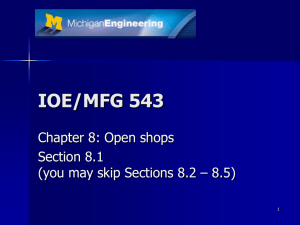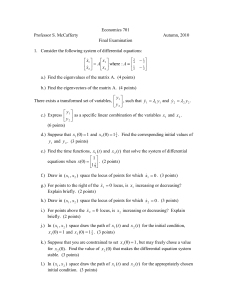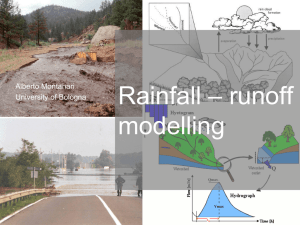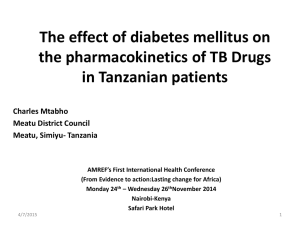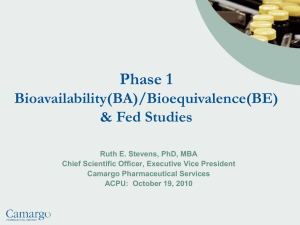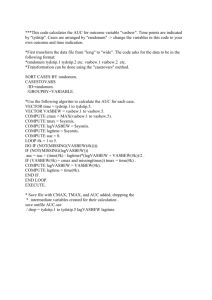lab15i - Academic Program Pages at Evergreen
advertisement
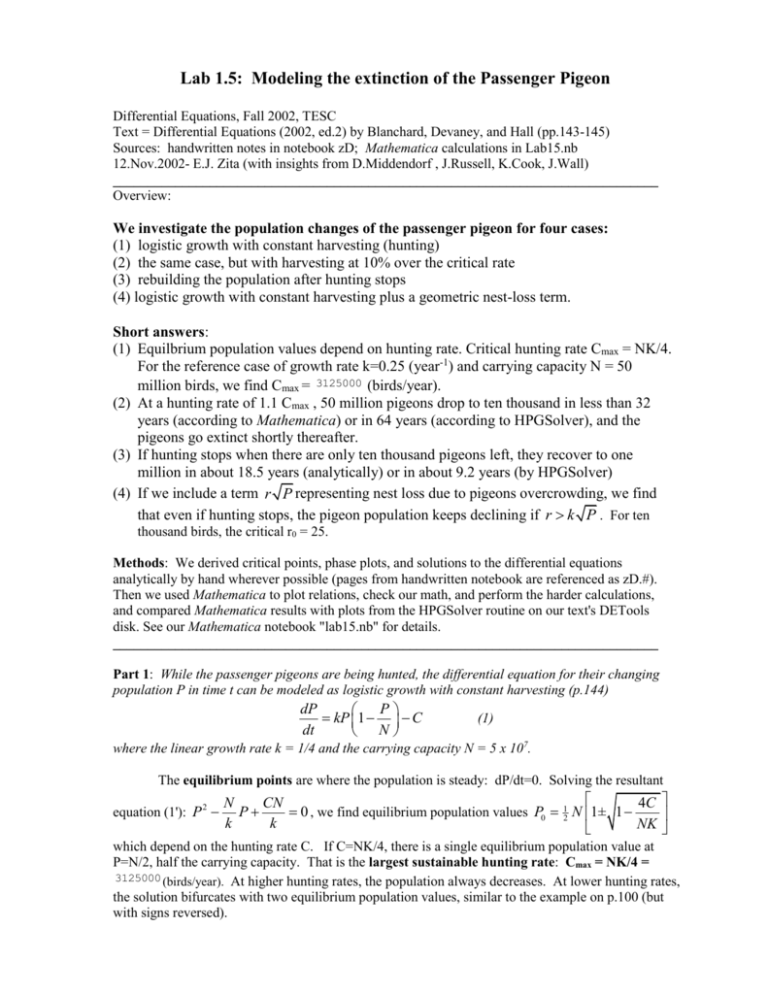
Lab 1.5: Modeling the extinction of the Passenger Pigeon
Differential Equations, Fall 2002, TESC
Text = Differential Equations (2002, ed.2) by Blanchard, Devaney, and Hall (pp.143-145)
Sources: handwritten notes in notebook zD; Mathematica calculations in Lab15.nb
12.Nov.2002- E.J. Zita (with insights from D.Middendorf , J.Russell, K.Cook, J.Wall)
_______________________________________________________________________________
Overview:
We investigate the population changes of the passenger pigeon for four cases:
(1) logistic growth with constant harvesting (hunting)
(2) the same case, but with harvesting at 10% over the critical rate
(3) rebuilding the population after hunting stops
(4) logistic growth with constant harvesting plus a geometric nest-loss term.
Short answers:
(1) Equilbrium population values depend on hunting rate. Critical hunting rate Cmax = NK/4.
For the reference case of growth rate k=0.25 (year-1) and carrying capacity N = 50
million birds, we find Cmax = 3125000 (birds/year).
(2) At a hunting rate of 1.1 Cmax , 50 million pigeons drop to ten thousand in less than 32
years (according to Mathematica) or in 64 years (according to HPGSolver), and the
pigeons go extinct shortly thereafter.
(3) If hunting stops when there are only ten thousand pigeons left, they recover to one
million in about 18.5 years (analytically) or in about 9.2 years (by HPGSolver)
(4) If we include a term r P representing nest loss due to pigeons overcrowding, we find
that even if hunting stops, the pigeon population keeps declining if r k P . For ten
thousand birds, the critical r0 = 25.
Methods: We derived critical points, phase plots, and solutions to the differential equations
analytically by hand wherever possible (pages from handwritten notebook are referenced as zD.#).
Then we used Mathematica to plot relations, check our math, and perform the harder calculations,
and compared Mathematica results with plots from the HPGSolver routine on our text's DETools
disk. See our Mathematica notebook "lab15.nb" for details.
_______________________________________________________________________________
Part 1: While the passenger pigeons are being hunted, the differential equation for their changing
population P in time t can be modeled as logistic growth with constant harvesting (p.144)
dP
P
kP 1 C
dt
N
(1)
where the linear growth rate k = 1/4 and the carrying capacity N = 5 x 107.
The equilibrium points are where the population is steady: dP/dt=0. Solving the resultant
equation (1'): P 2
N
CN
4C
P
0 , we find equilibrium population values P0 12 N 1± 1
k
k
NK
which depend on the hunting rate C. If C=NK/4, there is a single equilibrium population value at
P=N/2, half the carrying capacity. That is the largest sustainable hunting rate: Cmax = NK/4 =
3125000 (birds/year). At higher hunting rates, the population always decreases. At lower hunting rates,
the solution bifurcates with two equilibrium population values, similar to the example on p.100 (but
with signs reversed).
Note that the point C = Cmax and P=N/2 satisfies the mathematical conditions for a bifurcation
point: d2P/dt2=0 (node) and dP/dt=0 (equilibrium) at this point.
We use Mathematica to plot dP/dt vs P (eqn.1) for various values of the hunting rate C in terms of the
critical hunting rate Cmax = kN/4 = 3125000 .
Red: Cmax /2; Green: Cmax; Blue: 2 Cmax
C ranges from Cmax /4 to Cmax
Equilibrium
f = dP dt
4 ´ 10
1 ´ 10
-2 ´ 10
7
2 ´ 10
7
3 ´ 10
7
4 ´ 10
7
-6 ´ 10
7
P
5 ´ 10
7
3 ´ 10
7
6
2 ´ 10
-4 ´ 10
P values
6
1 ´ 10
7
7
6
1.5 ´ 10
Phase line for Cmax /2
P-
P+
6
2 ´ 10
6
2.5 ´ 10
6
3 ´ 10
6
C
Bifurcation diagram above: The only
equilibrium for C = Cmax. is at P=N/2, and that
is an unstable equilibrium. There are no
equilibria for C > Cmax, and there are two (P=+
and P-) whenever C < Cmax.
There is a stable equilibrium point (dP/dt<0 above and dP/dt >0 below), a sink, at
4C
4C
1
P 12 N 1+ 1
and a source at P 2 N 1- 1
.
NK
NK
In sum, for hunting rates below Cmax,
populations starting out above (P > P+) will drop to P+ and remain steady,
populations starting out between (P- < P < P+) will increase to P+ and remain steady, and
populations starting out below P- will go extinct.
Analytic solutions:
Equation (1) is an integral of the form solved in the CRC manual page A-188 or Dwight 160.01 (p.38)
dx
X ax
2
dx
bx c
k
N
dP
dt where P = x and
P kP C
2
2
2ax b
tan 1
when q 4ac b2 0
q
q
a=K/N = 5 x 10-9, b = -K = -1/4, and c=C varies,
2ax b q
1
log
q
2ax b q
q
2
when q 0
2ax b
when q 0
4K
C K 2 > 0 when C > Cmax
N
q<0 when C < Cmax
q=0 when C = Cmax
Dy
A@
D ik@
D@
DE
{@
H
L
i
y
A
A
E
E
@ Dk
{
@8
@@
@
D8
<D
D8 <
H
L
<
D
H
L
HL
We should get equivalent solutions to the diffeq (1) using the integrator in Mathematica:
y t
DSolve y' t == - C + k y t -
2
, y t ,t
N
After solving for an undetermined integration parameter in terms of an arbitrary initial condition y0,
we can simplify the general solution to the form (2):
y y0_, c_, t_
:=
1
2
nn
kn
4 c - kn nn Tan
4 c- kn nn t
2
nn -
nn
kn
+ ArcTan
nn
nn- 2 y0
4 c- kn nn
;
kn
where we assign numerical values for nn=N, kn=K, and c=C, such as ccn = Cmax.
We plot families of these solutions using commands such as:
Plot Evaluate Table y y0, ccn 2, t , y0, .2 * nn, 1.4 * nn, .2 * nn
AxesLabel ®
P
Cmax
7 ´ 10
6 ´ 10
5 ´ 10
4 ´ 10
3 ´ 10
2 ´ 10
1 ´ 10
, t, 0, 12 ,
Cmax 2 "
2
P
Cmax
7
7
6 ´ 10
7
7
4 ´ 10
7
7
2 ´ 10
7
7
7
7
2
HL
2
P
"t", "P
4
6
8
10
12
1.1 Cmax
6 ´ 10
4 ´ 10
2 ´ 10
4
10
12
t
P
HL
2 Cmax
7
5 ´ 10
7
2.5 ´ 10
7
7
7
2
-4 ´ 10
8
t -2 ´ 10 7
2
-2 ´ 10
6
7
7
4
6
8
10
12
t -2.5 ´ 10
-5 ´ 10
-7.5 ´ 10
4
6
7
7
7
Numerical solutions: In the absence of an analytic solution derived either by hand or in
Mathematica, you could calculate and plot families of solutions to (1) using Euler's method.
8
t
_______________________________________________________________________________
Part 2: If the harvest rate was 110% of Cmax, how long would it take for the population to decline to
P1 = 10,000 = 104, assuming that the initial population was near the carrying capacity?
We can linearize about an equilibrium point (as in 1.9 # 22) in the handwritten notes (zD.35) to obtain
an analytic approximation. Far from equilibrium points, however (e.g. at P ~ N or P ~ P1), the
linearization solution does not hold. (For example, the solution involves a log with a negative
argument near P1.)
Assume that P(0) = N = 50,000,000 = 5 x 107 and investigate solutions with Mathematica (see
attached file Lab15.nb).
The solution to equation (1) for this case is:
P pigeons
P(t) =
8
<
A
E
N
N-
4 C - k N Tan
k
k
4 C- k N t
2
4 ´ 10
N
(2')
At a hunting rate of 1.1 Cmax, the population
drops to P1 = 10,000 in 31.9886 years,
2 ´ 10
7
7
5
-2 ´ 10
10
15
20
25
30
35
HL
t years
7
and all pigeons disappear within t=32 years.
(Population does not go negative - it stops at 0.)
HPGSolver gives a different solution. It shows the population declining from N to P1 ~ 0 in 64 years, a
factor of two difference. Why?
Estimation: You can get a very rough solution to the problem above by simply inserting numbers.
If the population starts out near the carrying capacity, then 1
P
0 and the diffeq (1) becomes
N
(3) dP/dt = - C, which is simply linear decay, with a solution P = a - Ct. Using the initial condition
P(0) = N, we determine the integration constant a = N and find the general solution to (3):
(4) P(t) = N - Ct. Then the time it takes for the population to decline to P1 in this approximation is:
t1
N P1 5 107 104
14.5 years
C
1.1 165 107
The population doesn't really decay linearly - it actually takes longer to drop to P1, as seen above.
If you draw linear decay from t=0 on the DETools plot above, it does drop to P=0 in about 15 years,
which suggests the factor of 2 error is in the Mathematica calculation.
_______________________________________________________________________________
Part 3: Once the population reaches P1 = 104, how long would it take to rebuild to a million birds
(P2 = 106) if harvesting were completely halted (C=0)?
An analytic solution is tractable in this case. The diffeq is simple logistic growth:
dP
P
kP 1
dt
N
(4)
This is a separable equation that can be integrated with the same method we used in Lab 1.4 part 2.
dP
k
P( N P) N dt
1
1 1
1
(kt )
N PN
N ( N P ) N
N P
ln P ln( N P ) ln
kt
P
N P
kt
Be
P
N
P (t )
1 Be kt
Use partial fractions to write
1
1
1
P( N P) PN N ( N P)
cancel (1/N) terms and multiply by (-1)
Use the initial condition P(0) = P1 to find
B = (N - P1) / P1= 4999
(5)
This is the general solution to (4) above.
We can solve P(t2) = P2 = 106 analytically to find that the time to return the population to 100,000
pigeons is 18.5 years (after t1.)
N P
e kt
PB
N P
PB
kt ln
ln
PB
N P
6
1
PB
1 10 *5 103
t ln
ln
k N P 1 4 5 107 106
t 4 ln (102) 18.5 years
Pigeons recover after hunting stops.
Zoom in to see that P=100,000 after 18.5 years.
analytic
N
P = €€€€€€€€€€€€€€€€
€€€€€€€€
€€€€
- k
t€€
7 1 + B* E
5 ´ 10
4 ´ 10
3 ´ 10
2 ´ 10
1 ´ 10
Pigeons
1.4 ´ 10
1.2 ´ 10
7
7
1 ´ 10
800000
7
600000
7
10
20
30
40
50
HL
recovering
6
6
6
400000
200000
t years
5
10
15
20
HL
t years
HPG solver gives a solution different by a factor of 2 again: it shows the time to grow from
P1=10,000 to P2=100,000 is about 9 years.
_______________________________________________________________________________
Part 4:
If the pigeons cluster in trees so densely that the branches come tumbling down, nestlings and all,
the new diffeq could include a loss term proportional to the size of a circular cluster of birds,
where r is a geometric factor:
dP
P
kP r P 1 C
dt
N
(6)
If there is no hunting (C=0), there are equilibrium points (dP/dt=0) when P=0, P=N, and P
k2
.
r2
So the population is steady if there are no pigeons, if they are at carrying capacity, or when the nestloss geometric factor has the critical value r0 k P . If the population starts at P = P1 = 104 and the
growth rate is k = 1/4, then the critical nest-loss factor is r0 = 102/4 = 25.
Assuming P<N, so the second term in parentheses in (6) is positive,
we can see that for higher values (r > r0), the population declines, and for (r< r0) the population grows.
H
L
H
L
Red: Cmax /2; Green: Cmax; Blue: 1.1 Cmax;
Black: C=0 (all for r=r0)
f = dP dt
3 ´ 10
2 ´ 10
1 ´ 10
-1 ´ 10
-2 ´ 10
-3 ´ 10
Red: r0; Green: 20 r0; Blue: 40 r0
(all for C=0: just shift down if C>0)
f = dP dt
c
6
3 ´ 10
r
6
6
2 ´ 10
6
6
1 ´ 10
7
2 ´ 10
7
3 ´ 10
7
4 ´ 10
7
P
5 ´ 10
7
1 ´ 10
6
6
6
1 ´ 10
7
2 ´ 10
7
3 ´ 10
7
4 ´ 10
7
P
5 ´ 10
7
6
-1 ´ 10
6
There are no equilibrium solutions (for r= r0) for the hunting rate in part 2, C=1.1 Cmax.
In this case, dP/dt < 0 always, so the population is guaranteed to decline to zero no matter how high it
starts. Extinction is inevitable unless the hunting stops or the birds stop losing nests to overcrowding.
HPGSolver shows solutions for the critical nest loss rate,with no hunting, starting with 11,000
pigeons (growth), 10,000 (equilibrium) and 9,000 (decay to extinction).

